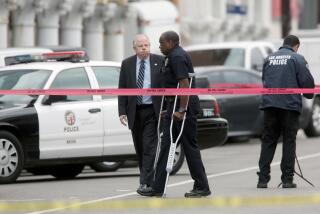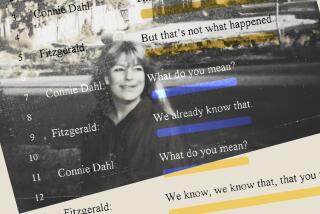Prof. Cooperman Slaying : Jury Quickly Selected as Lam Murder Trial Begins
- Share via
A rounded steel police lock covers the doorknob to Room 665B in Cal State Fullerton’s Science Building, the office of slain physics professor Edward Lee Cooperman. The door pane is covered with a shade to prevent anyone from seeing the dried blood and scattered papers inside.
Cooperman, 48, had two passions in life outside his family--teaching and organizing aid for Vietnam. He directed both endeavors from Room 665B, where he was fatally shot through the left side of the neck with a .25-caliber handgun on Saturday, Oct. 13, 1984.
Minh Van Lam, a 21-year-old Vietnamese student of Westminster, went on trial Thursday after noon before Orange County Superior Court Judge Richard J. Beacom on murder charges in the professor’s death.
It took only three hours Thursday for prosecution and defense attorneys to select a seven-woman, five-man jury.
International Attention The trial, expected to last about a month, is to resume Monday at 9 a.m.
Lam has said he shot Cooperman by accident when the professor grabbed his arm to show Lam how to use the gun.
The shooting has brought international attention to Orange County because Cooperman was widely known for efforts to organize scientific and humanitarian aid for Vietnam. There has been a heated debate over what, if any, importance Cooperman’s activities and political views may have played in his death.
Two widely varying theories have been promoted with equal zeal:
- The professor’s friends have suggested that Lam was involved in a political assassination plot and have demanded that police investigate right-wing elements in Orange County’s Vietnamese community. Police say they have yet to find evidence of a political conspiracy. Cooperman, after returning last July from a trip to Vietnam, told his family and friends he had received death threats which he feared were made by right-wing Vietnamese.
- Lam’s attorney, Alan May of Santa Ana, has argued that Cooperman’s ties to Communist-controlled Vietnam involved a secret life of political intrigue which somehow led him to his “accidental” death.
The flamboyant May, who has made many sweeping assertions about Cooperman’s private and public lives, says attention should be directed at Cooperman and what the lawyer considers his left-wing ties.
Prosecutors in the Orange County district attorney’s office believe the key to the shooting is the physical evidence inside Room 665B.
“You can debate all day about Dr. Cooperman’s politics; it doesn’t mean a thing,” said chief homicide prosecutor James Enright. “The jurors are going to picture in their minds what happened in that office when the professor was killed. And that’s what matters.”
If the Lam case is like most other murder trials in Orange County, the jurors will go to the scene of the shooting. But if they don’t, they will likely see the handful of pictures taken inside the office soon after the shooting was reported.
‘Like a Father to Me’ Those pictures, a major part of the prosecution’s case, show Cooperman’s blood on two opposite walls, a file cabinet, his desk and his telephone. They also show papers scattered on the desk.
Deputy Dist. Atty. Mel Jensen will contend that this was the scene of a struggle. Jensen will use testimony from a pathologist to try to support his “struggle” theory.
Two other pieces of evidence will be important to Jensen’s case: Lam’s tape-recorded statement to police and his videotaped re-creation of how Cooperman was killed.
Jensen plans to use those tapes to show that Lam’s “accident” explanation conflicts with the condition of the room. Other officials in the district attorney’s office believe the tapes at least will shock the jurors when they hear Lam explain his actions after the shooting.
Lam, a student of Cooperman in 1983, said the professor “was like a father to me.”
Yet after the shooting, Lam admits he left Cooperman lying on the floor without calling paramedics and without knowing whether Cooperman could be saved. He said he took a girlfriend to a movie.
Three to four hours later, Lam said he returned and placed the gun in Cooperman’s left hand (Cooperman was left-handed), then called campus police and acted as if he had just found the body. Lam admitted his involvement about three hours later, during police interrogation.
Most of the media attention in the case has been focused on Cooperman, partly because May has been steadily releasing information from files found in Cooperman’s office.
17 Years at Cal State Cooperman was a physics professor at Cal State Fullerton for 17 years. During most of that time, he was active in anti-war efforts and organizations promoting scientific and humanitarian ties with Vietnam.
He was an outspoken critic of American military involvement in Vietnam. When the war ended, Cooperman became involved with a scientific task force to help the country. In 1979, he founded the Scientific Committee for Cooperation with Vietnam and began traveling to Vietnam, sometimes twice a year.
May claims that Cooperman shipped high-technology equipment to Vietnam in violation of federal regulations. Cooperman’s associates say all the equipment was actually “low-tech” and that Cooperman scrupulously made sure that all shipments met State Department specifications.
Both sides agree that Cooperman, because of his interest in Vietnam, befriended many Vietnamese students, including Lam, a refugee who came to the United States at age 14.
The professor’s widow, Klaaske Cooperman, believes he wanted to help Lam, who had been in trouble with the police. She told law enforcement officials her husband had told her that Lam “was a good kid who just got mixed up with the wrong crowd.”
Charged With Auto Theft Lam was arrested Aug. 30, 1984, and charged with auto theft and later admitted to police that he drove for some juveniles when they broke into three cars on Aug. 29. In an interview at the Orange County Jail, Lam told The Times he was not aware he was breaking any law, since he did not steal anything himself.
Lam, who speaks softly in good English, has said in three jailhouse interviews with The Times that he left Cooperman to die only because he panicked. He said he regrets that he did not get help for the professor.
In the last interview, on Jan. 5, Lam said he can’t wait for the trial to start because “I want to get out of here.” (He’s been in jail since the night of the shooting, and his bail is now $200,000.)
“At my trial, I can prove I am innocent,” Lam said. “How can they say I am guilty when their own pathologist proved my innocence?”
The prosecutor’s pathologist is Dr. Richard Fukimoto, who performed the autopsy on Cooperman’s body and testified at Lam’s preliminary hearing in November.
Both sides agree that his testimony at the trial will be crucial.
The prosecution believes Fukimoto can show a clear conflict between Lam’s explanation of events and what really happened.
Lam said that after the gun “exploded,” he helped Cooperman to the floor, then left the room to see if anyone was in the hallway who could help. Lam then returned to the room, picked up his jacket and left. There was no blood all over the room at that time, Lam said in his interviews with The Times.
‘May Not Reach Jury’ May contends that Cooperman must have gotten up after Lam left, tried to telephone for help and fell across the desk, scattering the papers and getting blood on the walls and file cabinet.
Fukimoto testified that Cooperman’s wound was so severe that it was unlikely he could have gotten up, once on the floor.
May’s pathologist at the preliminary hearing, Dr. Rene Modglin of Riverside County, said Cooperman could have gotten up, but only in the first 10 seconds or so after he was on the floor.
May, however, insists that whether Cooperman could have gotten up is not relevant. What matters, May said, is Fukimoto’s testimony that he could not rule out the possibility an accident had taken place.
“This case may not even reach the jury,” May predicted. “If there are two clear views, one pointing to homicide and the other pointing to an accident, the court is obligated to accept the view that it was an accident. It’s insignificant whether Cooperman could have gotten up again.”
Officials in the district attorney’s office privately dispute May’s assertion that the trial will end that quickly.
May also had said the case probably would be dismissed at the preliminary hearing. But Municipal Judge Daniel T. Brice, who himself asked Fukimoto whether Cooperman could have stood up, ordered Lam to stand trial.
While May has been diligently compiling data on Cooperman’s Vietnam associations, even he is not yet sure yet how much of what he has gathered will be used at the trial.
Suicide Theory At one point, May said he would try to show that Cooperman committed suicide, using Lam as his instrument, because he was depressed over his failure to please both the State Department and the Vietnamese government. But just before Christmas, May said he changed his mind. He now says he hasn’t abandoned the suicide theory but assigns it a low priority.
May insists that Cooperman’s Vietnam associations are important. In documents filed with the court, May stated that because of problems Cooperman encountered on his last trip to Vietnam and problems he was having with the State Department, the professor’s “state of mind is material in explaining his actions leading up to and causing his own accidental death.”
May declined to reveal whether he will claim during the trial that Cooperman had homosexual tendencies. He advanced this theory strongly at the preliminary hearing, then in December told The Times he was abandoning the idea. He now says he has only abandoned part of the theory.
Since October, May has claimed that Cooperman surrounded himself with young Asian men in black leather jackets because of a possible sexual attraction to them. But now May claims Cooperman also wanted the young men around him as a deterrent to potential assassins.
No Motive Suggested Cooperman’s family and friends say Cooperman was not a homosexual and accuse May of character assassination.
One key element to May’s defense--aside from his investigation of Cooperman--will be the lack of a motive for murder, the lawyer says. Cooperman gave Lam money on several occasions, and prosecutors have not yet publicly suggested a clear motive.
Some of the more politically active friends of Cooperman who plan to attend the trial claim that May himself should be an issue.
Anthony Russo, a former Pentagon Papers defendant, for example, claims May is working for the Central Intelligence Agency and was hired by the same unknown people who induced Lam to kill Cooperman.
May laughingly denies such charges. In fact, as a joke, May had a fake badge made saying he was a CIA employee. He wore it to court one day inside his coat and flashed it at Russo.
Russo was not amused. “I’ve known that all along, Alan,” Russo said, grimly.
More to Read
Sign up for Essential California
The most important California stories and recommendations in your inbox every morning.
You may occasionally receive promotional content from the Los Angeles Times.










